The saga that created the modern blockbuster is “over.” And while The Mandalorian, a plethora of upcoming Disney+ shows, and a still-rumored Rian Johnson trilogy will keep the Far, Far Away galaxy on our screens until the heat death of this universe, the story of the Skywalkers’ universe has, it seems, seen its last frame.
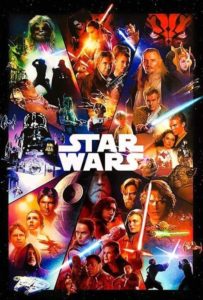 After nine films and forty-two years, a clear theme has emerged from the miles of footage devoted to the Star Wars saga: not one of high adventure, or black-vs-white, or even the Hero’s Journey that gave A New Hope its story structure and the world its distinctive, fantastic feel. Those are what make the films fun adventures, and give the stories soaring morality tales and thoughtful philosophical beats; but they’re not what the series is about.
After nine films and forty-two years, a clear theme has emerged from the miles of footage devoted to the Star Wars saga: not one of high adventure, or black-vs-white, or even the Hero’s Journey that gave A New Hope its story structure and the world its distinctive, fantastic feel. Those are what make the films fun adventures, and give the stories soaring morality tales and thoughtful philosophical beats; but they’re not what the series is about.
What it’s about, and the reason it’s been our dominant myth in Western culture for almost a half-century, are the interactions between the people (and the wookiees, and the droids). Each trilogy puts a family of one type or another at its center—their hardships drive the action, their banter drives the humor, and their morality forms the core of the trilogy’s philosophy.
Or, to put it more succinctly: wars may be won by men, but Star Wars are won by families.
I have a bad feeling about this: spoilers for all nine main-series Star Wars films follow.
Prequels: The Family you Fail
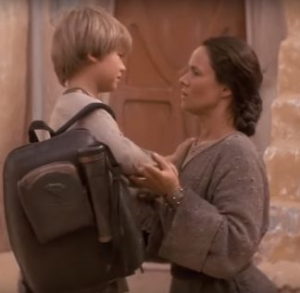 The Tragedy of Darth Vader spanning the Prequel Trilogy begins with a broken family, as Anakin is removed from his mother; and ends with Obi-Wan Kenobi shouting “you were my brother!” to Anakin’s burning body and burning heart as another family breaks.
The Tragedy of Darth Vader spanning the Prequel Trilogy begins with a broken family, as Anakin is removed from his mother; and ends with Obi-Wan Kenobi shouting “you were my brother!” to Anakin’s burning body and burning heart as another family breaks.
Throughout the middle is broken family after broken family. Anakin suffers the death of his mother Shmi, his Jedi father Qui-Gon, and his wife Padmé and (he believes) their unborn children. Not to mention the heartbreak of losing Obi-Wan, the Jedi Council, C-3PO, and Ahsoka Tano, his beloved padawan in the Clone Wars television series.
It’s a symphony of loss, and while it affects the entire cast, the nexus of all the loss is on Anakin Skywalker; whose failures, one way or another, lost him everything.
Sure, some of his losses were out of his control, but most of the depths to which Anakin Skywalker fell were descended to by his own sin; Anakin’s frantic attempts to keep his families together dragged him ever deeper into Palpatine’s web and proved his daughter’s eventual assertion to Governor Tarkin that “the more you tighten your grip, the more [family members] will slip through your fingers.”
Anakin’s bond with Obi-Wan is shattered because he’s trying to hold together his marriage, and will stop at nothing to save his wife—not even at the edge of morality. Bolstered by the recent loss of his mother, not even Padmé herself can change Anakin’s mind. And then, when Anakin throws in his lot with Palpatine, he loses Padmé herself.
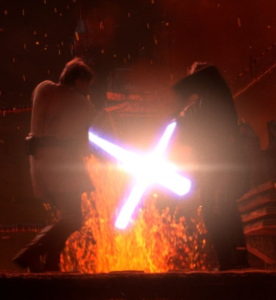 By the end of the Prequels, he has lost every family he ever had, to be replaced only by an adversarial and transactional relationship with Emperor Palpatine. By the time of Rogue One, Vader is a solitary, sadistic, pained individual who rules the galaxy as the Emperor’s right hand…but has no one and nothing.
By the end of the Prequels, he has lost every family he ever had, to be replaced only by an adversarial and transactional relationship with Emperor Palpatine. By the time of Rogue One, Vader is a solitary, sadistic, pained individual who rules the galaxy as the Emperor’s right hand…but has no one and nothing.
He’s not the only one hurting as a result of his sin, though. As Darth Vader, Anakin helps to bring about some of the greatest suffering the galaxy has ever known; sin, as Christian theologians have been noting for a long time, splatters. Just like all the nations are blessed when we obey the voice of God (Genesis 22:18), all the nations are harmed by our unfaithfulness and rebellion. Your sin could subjugate the whole galaxy.
Probably not. But it certainly can destroy a family or two; and it doesn’t even take much effort (2 Samuel 11). Sin and failure have massive repercussions that can seem impossible to repair. Your failure can seem unrecoverable.
Still, even the most horrifically-destroyed family can be fixed. As long as you live, there is hope for reconciliation.
Originals: The Family you Fix
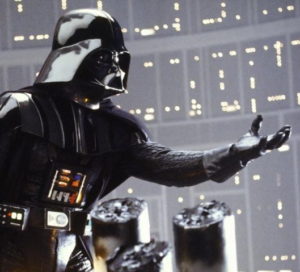 As the prequels start with a broken family, the Original Trilogy starts with recovering a family. Obi-Wan reunites with Luke, the boy he left behind so many years ago, and the family that he had with Anakin Skywalker is reconciled, in part, with Anakin’s son. We see R2-D2 and C-3PO reuniting as a family multiple times in the trilogy; the dysfunctional family of Han Solo, Chewbacca, and Lando Calrissian reconnecting after decades; and the family reunion of Luke, Leia, and Han on Jabba’s sail barge after Han is rescued from carbonite.
As the prequels start with a broken family, the Original Trilogy starts with recovering a family. Obi-Wan reunites with Luke, the boy he left behind so many years ago, and the family that he had with Anakin Skywalker is reconciled, in part, with Anakin’s son. We see R2-D2 and C-3PO reuniting as a family multiple times in the trilogy; the dysfunctional family of Han Solo, Chewbacca, and Lando Calrissian reconnecting after decades; and the family reunion of Luke, Leia, and Han on Jabba’s sail barge after Han is rescued from carbonite.
But, of course, the big daddy of all reconciliations, the family reunion that defined a half-century, the story point that looms over all others and changed film storytelling forever, is the reconciliation of the Skywalker family: Anakin, Luke, and Leia.
This reconciliation is hard-fought, requiring three of the biggest blockbuster films in history to tell the whole story. Luke begins to understand the basics of his broken family from Obi-Wan in A New Hope, things are fleshed out more fully in the famous and climactic moments of The Empire Strikes Back, but it’s not until the final scenes of Return of the Jedi that he’s reconciled to his father. “I’ll not leave you here,” he finally says. “I’ve got to save you.”
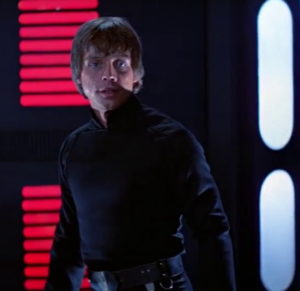 And, like with all reconciliations, it wouldn’t have been possible without sacrifice; maybe sacrificing our need to be right, or our desire for revenge. Vader sacrifices both, along with his very life.
And, like with all reconciliations, it wouldn’t have been possible without sacrifice; maybe sacrificing our need to be right, or our desire for revenge. Vader sacrifices both, along with his very life.
With that sacrifice, Luke is not only able to reconcile with his father, he is also able to find his sister and recover the family that he lost before his birth. Together, Luke and Leia mourn and celebrate their redeemed father, as well as the decisive victory he won.
The book of Colossians calls us “ambassadors for Christ,” with a plea directly from heaven: “be reconciled to God.” (2 Corinthians 5:20) This reconciliation, like Vader’s, required a sacrifice; but Jesus was innocent, sacrificing himself for His rebellious people so that reconciliation could happen. We are reconciled, and evil is destroyed forever. It is finished.
But not yet.
Sequels: The Family you Find
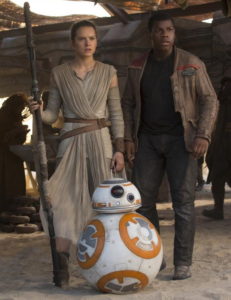 In the Disney-era Sequel Trilogy, we see families lost, found, reconnected, broken apart, dissected, reversed, undermined, and standing victorious. Mostly, though, we see so-called “found families.”
In the Disney-era Sequel Trilogy, we see families lost, found, reconnected, broken apart, dissected, reversed, undermined, and standing victorious. Mostly, though, we see so-called “found families.”
Found families, or Families of Choice, are all the rage these days. I learned about their existence from discussions of Joss Whedon’s Firefly (and, incidentally, Joss Whedon’s Avengers), but there are many more in pop culture: Harry, Ron, and Hermione in Harry Potter. The Guardians in Guardians of the Galaxy. [Spoiler] and [Redacted] in Knives Out. Anytime a group of asimilar, alienated, even antagonistic people join together with a bond closer than friendship, you’ve got a found family.
In the Star Wars Sequel Trilogy, we have these in spades: Leia and Han (formerly an actual family until hardship drove them apart), Kylo and Snoke, Finn and Rose, BB-8 and D-O. Many of these characters don’t have families of their own; Kylo ran from his, Finn was taken when he was young, Rose’s sister was killed during an attack led by Poe.
The idea of a found family is subverted by DJ in The Last Jedi, who insists that the only way to keep yourself from getting hurt and remain free is to follow the advice enshrined in the advice whose initials form his chosen alias: “Don’t Join;” as well as by Kylo Ren who urges Rey to “kill” the past which connects her to her family.
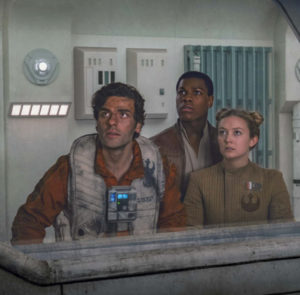 That drive from Rey also presents some tension with the Found Family concept, as she seeks to discover who she really is by finding her real family. Rey initially demands the universe reveal who she is, resisting all other families by staunchly remaining on Jakku and running from Anakin’s lightsaber. Then she gets a terrible answer: her family is nobody, and it seems like there’s no way it can get worse; until it turns out that her family actually connects her to an intergalactic despot.
That drive from Rey also presents some tension with the Found Family concept, as she seeks to discover who she really is by finding her real family. Rey initially demands the universe reveal who she is, resisting all other families by staunchly remaining on Jakku and running from Anakin’s lightsaber. Then she gets a terrible answer: her family is nobody, and it seems like there’s no way it can get worse; until it turns out that her family actually connects her to an intergalactic despot.
But the driving force of the trilogy is the resistance trio: Rey, Finn, and Poe. Their interplay and interaction carries the films as much as any three characters can. Finn and Poe’s family bond overcomes each of their shortcomings to make them more than they are on their own so that they can finally lead the Resistance together. it’s a family Rey desperately works to welcome Ben Solo into, eventually overcoming his deceptive would-be father figures Snoke and Palpatine, as well as the actual blood relationship between Palpatine and his true-born granddaughter Rey.
From family, we derive our nature; and as Christians, we’ve always been about finding a new family that transcends our blood relations. By His sacrifice, Jesus adopted us when we were slaves, choosing us as His family (Galatians 4:1-7) and giving us the core, defining identity of love for one another (John 13:35). This is a found family, and this is what we’ve been brought into as Christians.
Star Wars: A Family of Sacrificial Love
And it’s that sacrificial love that defines the families of the Star Wars saga: the victories they win, the achievements they make, are won not through superior power or hatred or cunning cleverness, but because they are devoted to their family, whatever type it is. From Luke telling his father that he knows there is still good in him and refusing to strike him down; to Obi-Wan preserving galactic hope by caring for the children of the man who betrayed him; to Rey saving Ben when she could’ve easily left him to die, not knowing that he would later save her and the galaxy itself.
Powerful though he is, Palpatine falls short in each trilogy because the heroes make the struggle a family affair. The families of Star Wars keep the galaxy free not by betraying their family’s principles for a simple or expedient victory, but by coming back to save their family even when they have a bad feeling about this. Put simply, they win not by fighting what they hate…but by saving what they love.


1 comment